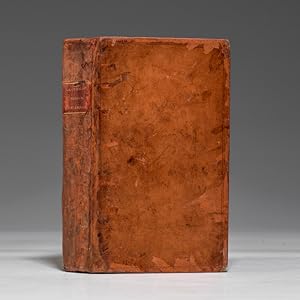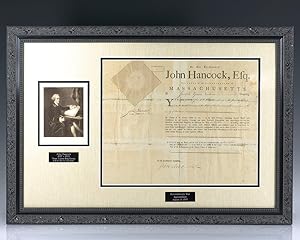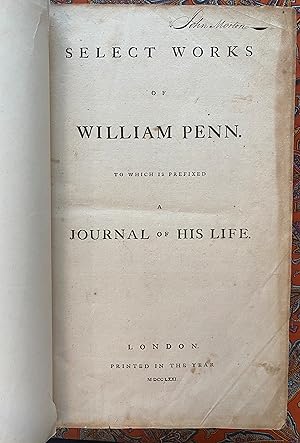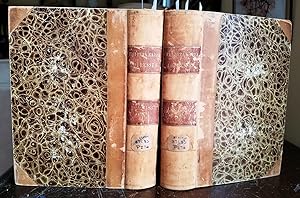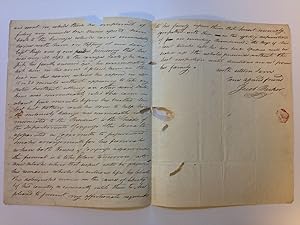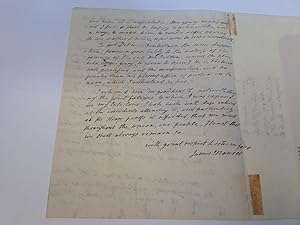Declaration Independence, Signed (396 results)
Product Type
- All Product Types
- Books (371)
- Magazines & Periodicals (2)
- Comics
- Sheet Music
- Art, Prints & Posters (6)
- Photographs (2)
- Maps (1)
-
Manuscripts &
Paper Collectibles (14)
Condition
Binding
Collectible Attributes
- First Edition (178)
- Signed
- Dust Jacket (124)
- Seller-Supplied Images (217)
- Not Printed On Demand (388)
Free Shipping
Seller Location
Seller Rating
-
Constitutions des Treize Etats-Unis De L'Amerique. [Constitutions of the Thirteen United States of America].
Published by D. Pierres/Pissot, Pere & Fils, Libraries, Paris, 1783
Seller: Raptis Rare Books, Palm Beach, FL, U.S.A.
First Edition Signed
First French edition of the Constitution of the United States of America, inscribed by Founding Father Benjamin Franklin who had the translation published and personally distributed each of the 600 copies produced. Octavo, bound in one quarter calf with gilt ruling to the spine, burgundy morocco spine label lettered in gilt. Presentation copy, inscribed by Benjamin Franklin on the front free endpaper, "A Madame, Madame la Presidente de Manieres [sic] de la parte du. B. Franklin." The recipient, Madame Durey de Meinires was a a French writer best known for her translations of Samuel Johnson, David Hume, and Sarah Fielding. On March 24th, 1783, Franklin wrote to the Comte de Vergennes, "I am desirous of printing a translation of the Constitutions of the United States of America, published at Philadelphia, by Order of Congress. Several of these Constitutions have already appeared in the English and American newspapers but there has never yet been a complete translation of them." At Franklin's suggestion, the Duc de La Rochefoucault produced the first French translation, and Franklin¬is believed to have contributed the fifty-plus footnotes.¬Franklin had 600 copies of Constitutions des Treize Etats-Unis de l'Amerique privately printed by Philippe-Denis Pierres, first printer ordinary of Louis XVI, which were not made available for sale. Franklin distributed them himself, and was happy to fulfill the request of Madame Durey de Meinires, who wished to receive a copy. On August 31, 1783, Franklin sent a copy of the newly published volume to Madame Durey de Meinires, along with a letter, "I send with great Pleasure the Constitutions of America to my dear & much respected Neighbour, being happy to have any thing in my Power to give that she will do me the honour to accept, and that may be agreeable to her." The inscribed page included in the present volume was previously sold as a loose flyleaf by Charles Hamilton in 1959, and it has since been professionally tipped into an edition of the book with which it was originally sent. The book contains the Constitutions of each of the thirteen States of America, the Declaration of Independence of the 4th of July 1776, the Friendship and Commerce Treaty, the Alliance Treaty between France and the United States, as well as the treaties between the United States and the Netherlands and Sweden. The title page contains the first appearance of imprint of the United States seal in a book. Franklin's grand gesture in publishing and distributing these constitutions‚ about which there was intense interest and curiosity among statesmen‚ was one of his chief achievements as a propagandist for the new American republic. In good condition. Benjamin Franklin earned the title of "The First American" for his early and indefatigable campaigning for colonial unity, initially as an author and spokesman in London for several colonies. As the first United States Ambassador to France, he exemplified the emerging American nation. Franklin‚ s contributions to science and politics were immense and his passion for making books more available to a broader audience prompted him to establish North America‚ s first subscription library. In 1731, Franklin convinced the members of his Junto (a mutual improvement club he founded) to pool their money to purchase books they would collectively share. The collection became the Library Company of Philadelphia and is now regarded as the predecessor to the public library. Franklin was also instrumental in the establishment of the Library of the Pennsylvania Hospital (North America‚ s first medical library), the Pennsylvania State Library, The Library of the American Philosophical Society, and the Library of the University of Pennsylvania.
-
Second Congress of the United States: At the First Session, begun and held at the City of Philadelphia, in the State of Pennsylvania, on Monday the twenty-fourth of October one thousand seven hundred and ninety-one. An Act to extend the Time limited for settling the Accounts of the United States with the Individual States.
Published by Childs & Swaine, Philadelphia, 1792
Seller: Raptis Rare Books, Palm Beach, FL, U.S.A.
Signed
Scarce printing of an early United States law providing for the funding of the national debt, signed by Thomas Jefferson as Secretary of State. Folio, one page. The document, which also carries the printed signatures of President George Washington, Vice President John Adams, and House Speaker Jonathan Trumbull, was approved January 23, 1792. Individual acts and bills of the first Congresses were routinely printed for public consumption. A provision was made, however, to print a few copies of each act for dissemination to the states, and to have each copy signed by Secretary of State Thomas Jefferson. One of the main priorities of the federal government in the early national period was to pay down the debt of the United States. The national debt was incurred during the Revolution and augmented in 1790 when the Congress passed the Assumption Act, in accordance with a plan devised by Alexander Hamilton. Because contacting the numerous and geographically dispersed holders of the debt proved more difficult than expected, it became necessary to extend the time allowed by law for making the relevant financial arrangements. The present act accomplished this, and made a special extension of five months for Vermont, which gave the new state time to calculate the amount of debt. Despite Jefferson's vehement opposition to Hamilton's plan when it was formulated, his position as Secretary of State necessitated his signature on the presentation copies of the acts that effected it. In fine condition. Housed in a custom half morocco folding case. Scarce, with only one other example signed by Jefferson located. American Founding Father Thomas Jefferson was the principal author of the Declaration of Independence and later served as the third President of the United States from 1801 to 1809. Prior to his presidency, he was elected the second Vice President of the United States, serving under John Adams from 1797 to 1801. A proponent of democracy, republicanism, and individual rights motivating American colonists to break from Great Britain and form a new nation, he produced formative documents and decisions at both the state and national level. Jefferson was an avid bibliophile and, by the end of his life, had amassed a large library and wine collection.
-
An Account of the War in India, Between the English and French, on the Coast of Coromandel, From the Year 1760. Together with A Relation of the late Remarkable Events on the Malabar Coast, and the Expeditions to Golconda and Surat; with the Operations of the Fleet. Illustrated with Maps, Plans &c. The Whole Compiled from Original Papers.
Published by Printed for T. Jefferys, London, 1761
Seller: Raptis Rare Books, Palm Beach, FL, U.S.A.
First Edition Signed
Benjamin Franklin's first edition copy of Cambridge's account of the progression of the Seven Years' War in India, from Franklin's private library. Quarto, bound in full contemporary calf, marbled endpapers, illustrated with 12 engraved maps and plans and 6 plates, mostly folding. From the private library of Benjamin Franklin. Franklin's contributions to science and politics were immense and his passion for making books more available to a broader audience prompted him to establish North America's first subscription library. In 1731, Franklin convinced the members of his Junto (a mutual improvement club he founded) to pool their money to purchase books they would collectively share. The collection became the Library Company of Philadelphia and is now regarded as the predecessor to the public library. Franklin was also instrumental in the establishment of the Library of the Pennsylvania Hospital (North America's first medical library), the Pennsylvania State Library, The Library of the American Philosophical Society, and the Library of the University of Pennsylvania. Franklin's private library has a long and complex history and although he was known to have produced a list its contents shortly before his death, it has never been discovered. After his death in 1790, a large portion of his library became the property of his grandson, William Temple Franklin who, upon receiving it, quickly sold it to financier and Signer of the Declaration of Independence Robert Morris. When Morris went bankrupt at the end of the decade, the collection went into the hands of Philadelphia bookseller and former French tutor Nicholas G. Dufief (in 1801), who began offering volumes for sale to the public. Dufief attempted to interest Congress in obtaining most of the library, but ultimately sent most of it to auction. On March 12, 1803 Philadelphia auctioneers Shannon & Poalk sold the library and Philadelphia attorney William Rawle purchased the present volume, inscribing it: "W. Rawle 1803 ‚ " bo't at sale of Dr. Franklin's library." Dufief was also known to have compiled a list of the contents of Franklin's library, but it has never been recovered and, although printed catalogs were known to be issued advertising the contents of the 1803 Shannon & Poalk auction, a copy has not been located. Philadelphia autograph collector Ferdinand J. Dreer obtained this copy and in 1886 and presented it to the Society of the Sons of St. George. In good condition. With Dreer's bookplate and presentation inscription. Housed in a custom clamshell box. Rare and desirable from Franklin's private library and with noted provenance. Benjamin Franklin earned the title of "The First American" for his early and indefatigable campaigning for colonial unity, initially as an author and spokesman in London for several colonies. As the first United States Ambassador to France, he exemplified the emerging American nation. Franklin was foundational in defining the American ethos as a marriage of the practical values of thrift, hard work, education, community spirit, self-governing institutions, and opposition to authoritarianism both political and religious, with the scientific and tolerant values of the Enlightenment. In the words of historian Henry Steele Commager, "In a Franklin could be merged the virtues of Puritanism without its defects, the illumination of the Enlightenment without its heat." To Walter Isaacson, this makes Franklin "the most accomplished American of his age and the most influential in inventing the type of society America would become.".
-
[Manuscript map of the "Waldo Patent" principally depicting the land between the Muscongus River and Penobscot Bay]
Published by [Newport, R.I., 1767
Seller: Donald A. Heald Rare Books (ABAA), New York, NY, U.S.A.
Map Signed
Manuscript map in ink and wash, on a single folio sheet, 15 1/4 x 19 inches. Docketed in manuscript on verso, "Map of Leveretts Patent alias Muscongus." With two manuscript documents, one being [3]pp. on folio sheets, dated at Boston May 19, 1787; the other being [3]pp. on folio sheets, dated at Providence, R.I. on May 30, 1787. Also, with a half-page of manuscript dated Boston, March 28, 1768. All three documents relating to the lands depicted on the map. Map with minor separations along horizontal fold. The half-page document being only the beginning portion of a longer letter, otherwise the manuscripts in near fine condition. A highly important manuscript map of Colonial Maine: heavily annotated by William Ellery, a signer of the Declaration of Independence from Rhode Island. An attractive eighteenth century manuscript map of Penobscot Bay, Maine, heavily annotated by William Ellery, a signer of the Declaration of Independence from Rhode Island, who made claims to some of the lands depicted on the map. The map was drawn by British Rear-Admiral Jahleel Brenton, who commanded the HMS Queen during the Revolution, and whose family lost much of its property as a result of the Revolution. The map is skillfully rendered, as would be expected of a British naval officer, and is done on a scale of about three miles to the inch. The map depicts the coastline from the Damariscotta River in the southwest to the Penobscot River in the northeast, and shows and names the many islands of the Bay, as well as many inlets, harbors, rivers, ponds, etc. The location of a fort and settlements have also been added. This information was all added by William Ellery (1727-1820), a signer of the Declaration of Independence from Rhode Island. Ellery explains in a manuscript note in the lower right corner of the map (dated at Newport, Rhode Island in 1767): "This map of Leverett's Patent &c was copied from a copy, by Jahleel Brenton Esq., one of the Proprietors; and presented by his son Samuel Brenton to William Ellery who wrote the References, Names of Places, &c. William Ellery." In the upper left corner of the sheet Ellery has added a long manuscript note explaining the survey and the boundaries of Leverett's Patent, as depicted on the map. This map and the accompanying manuscript documents were found among William Ellery's papers, and were part of Ellery and his brother Benjamin's attempts to claim lands in Maine that they believed belonged to their family. "Leverett's Patent," also known as the Waldo Patent or the Muscongus Patent, was issued in 1629 to Thomas Leverett and John Beauchamp. It granted land and trading rights for a thirty-six square mile area along the Penobscot Bay in present-day Maine, between the Muscongus River and Penobscot River. According to the documents present here, Leverett inherited the full patent upon Beauchamp's death, and at his own death divided the grant among his ten children, who then divided the land again amongst the next generation. Around 1720 Gen. Samuel Waldo of Boston acquired a large portion of the patent, and began recruiting immigrants from Germany to settle the area. The letter fragment present here (dated March 28, 1768 and addressed to Benjamin and William Ellery) asserts that the Ellerys have an "undoubted right to a half share" of the Muscongus lands, as a result of a purchase made by their grandfather. The unidentified author of the letter goes on to describe the Waldo heirs as "exceeding difficult to deal with." Also present are two manuscripts, one being a 1787 copy of the original 1629 grant of the Muscongus Patent from the Council of Plymouth, the other being a manuscript deed of sale signed by James Green for a portion of the original patent. A handsome colonial era manuscript map of the coast of Maine, drawn by a British Rear-Admiral and used by a signer of the Declaration of Independence to defend his family's claims to the land. Significant manuscript maps of this early date are virtually unknown in the market.
-
Manuscript document signed
Publication Date: 1788
Seller: Bauman Rare Books, Philadelphia, PA, U.S.A.
Signed
"FRANKLIN, Benjamin. Manuscript document signed. Philadelphia: March 12, 1788. Single sheet of vellum, 15-3/4 by 13-1/2 inches, writing on recto, with fragile paper seal, with later engraving of Franklin. Silk matted, floated and window framed, entire piece measures 22 by 32 inches. $34,000.Exceptional original manuscript document in a secretarial hand, a deed conveying to "Peter Baker a certain tract of land called 'Baker's Delight' situate[d] in Antrim Township Franklin County," boldly signed by Benjamin Franklin as President of Pennsylvania, countersigned by Secretary Charles Biddle, and with the fragile paper seals of Pennsylvania present and intact.This rare official document, dated March 12, 1788, is boldly signed by Benjamin Franklin as President of Pennsylvania below the state's embossed seal. Franklin was not only the state's president, but also a delegate to the Constitutional Convention, convened in Philadelphia on May 25 of this year. Franklin is the only Founding Father to be signatory to all four key documents in America's founding: the Declaration of Independence, Treaty of Paris, Treaty of Alliance with France and the U.S. Constitution. Franklin served as President of Pennsylvania from October 1785 to October 1788. It is in that capacity that he signed this document.The document, entirely in manuscript in a fine and legible secretarial hand, reads, in part: "The Supreme Executive Council of the Commonwealth of Pennsylvania. To all to whom these Presents shall Come Greeting. Know ye that in consideration of the monies paid by Samuel Findley to the late Proprietaries at the granting of the Warrant hereinafter mentioned and of the Sum of twenty nine pounds ten shillings lawful money now paid by Peter Baker into the Receiver Generals Office of this Commonwealth there is granted by the said Commonwealth to the said Peter Baker a Certain Tract of Land called "Baker's Delight" Situate in Antrim Township Franklin County In Witness of whereof His Excellency Benjamin Franklin Esq., President of the Supreme Executive Council hath hereto set his hand and caused the State Seal to be hereto affixed in Council the twelfth day of March in the year of our Lord one thousand seven hundred and eighty eight and of the Commonwealth the Twelfth. Attest Charels Biddle Sec'y. [signed in the left margin, with flourish] Benjamin Franklin." The original fragile, ornate, eight-pointed star paper seal is present, faintly embossed with the seal of Pennsylvania. Docketed on verso with two additional embossed paper seals affixed. Fold lines, a bit of toning to vellum. Star seal at top left is missing one point, and most points have folds. Franklin signature bold and clear. Beautifully framed.". Signed.
-
Condition: Near Fine. Pierre Charles Cior (illustrator). Original. Three-quarter's view gouache portrait of Gilbert du Motier, the Marquis de Lafayette (1757-1834), in the dark blue uniform with gold epaulettes of a Major-General of the American Continental Army during the 1780's; his image in flanked to his right by a tiny row of soldiers bearing weapons and a flag. This portrait miniature on ivory has been inserted into the lid of a round box made of toirtoise-shell with gold mounting and glass dome; (unframed image: 2.8" x 2.8" / 7.2 x 7.2 cm; framed: 3.2" x 3.2" / 8.1 x 8.1 cm); signed by Pierre Charles Cior, the French miniaturist, as "P. Cior" and dated "an 3e" or the 3rd year of the French Revolution, that is, 1795/96. This gouache portrait miniature on ivory is of the dashing young Marquis de Lafayette in the impressive dark blue uniform of a Major-General of the American Continental Army under the command of George Washington. One can see a faint line of soldiers to his right. It may have been based on a certain painting (possibly lost today), or an engraving--both from the 1780's. It was executed by the French miniaturist Pierre Charles Cior (1769-ca.1840) during the third year of the French revolution, i.e., 1795 or 1796. For comparables, see the oil on canvas executed by Joseph Boze in 1790; the engraving by FranÁois Sťraphin Delpech in the National Portrait Gallery; and the oil signed and dated "G. Bevalet, 1788" sold by Skinner Auctions, June 8, 2008. The Marquis de Lafayette defied his government and left France at the age of 19 in 1777, hoping to serve courageously as a volunteer in the American war for independence from Great Britain. Already a skillful diplomat, Lafayette hoped for military command. In cooperation with Benjamin Franklin, Lafayette had already exercized important influence on the French king by trying to convince him of the need to increase France's financial and military commitment to the American cause. Lafayette was especially fortunate in his new relationship with George Washington, who took him under his wing, treated him like a son, and enabled the Marquis to serve honorably and with high rank in the Continental Army. (Subsequently, the Marquis named his own son "Georges Washington" in fond remembrance.) Lafayette was also a close friend of Alexander Hamilton and Thomas Jefferson. During the Marquis' service in the Continental Army, he spent most of December 1777 and January 1778 in winter quarters at Valley Forge with Washington and his ragged troops. The wealthy Frenchman spent significant sums from his own fortune to help the beleaguered and frostbitten men. He also supported Washington when rebellious soldiers during the "Conway Cabal" tried to compel their general to give up command. During his first action at Brandywine on September 11, 1777, Lafayette displayed extreme courage under fire as he led his men in an orderly retreat. During the skirmish, he was severely wounded in the calf, yet managed to survive. Thereafter, he was given command of a division of men. Lafayette also fought in the battles of Glouchester, Barren Hill, Rhode Island, Monmoth, Green Spring; and at the siege of Yorktown, where he blocked British troops led by General Charles Cornwallis and contributed to this major surrender of British forces. After the war with Britian had been won in America by the combined arms of Americans and their French allies, Lafayette returned to France, where he risked his life in inspired but vain efforts to bring democracy to his land. He sought a government of balance between competing interests and moderation that would support democratic values. At the outbreak of the French Revolution in 1787, when he was just 29, Lafayette was appointed to the Assembly of Notables. He lobbied for the convocation of the Estates General and became a deputy for the Second Estate. Two years later, he joined the newly formed National Assembly and was elected as its vice president. An empassioned advocate of individual rights, Lafayette took a lead role in the creation of the Declaration of the Rights of Man. On July 15th, immediately after the fall of the Bastille prison, the electors chose Lafayette to be commander-in-chief of the National Guard and military head of the new government. Though his views were liberal, and he sought a peaceful transition, Lafayette's important roles put him in a dangerous position between the royals, democrats, and radical revolutionaries. In October 1789, Lafayette led his troops at Versailles to protect the king and his family from a possible mob attack; then he accompanied the Royals back to Paris. In February 1791, Lafayette and his National Guard intervened in a stand off between armed nobles and a Parisian mob--later dubbed "the Day of Daggers." Discouraged by the rising violence, Lafayette tried to resign but was dissuaded from doing so. In July 1791, Lafayette felt compelled to order the National Guard to open fire on a dangerous mob at the Champ de Mars, a massacre that killed more than 50 rioters. This bloody incident shattered whatever respect Lafayette still enjoyed among the radical Jacobins and sans culottes.By mid-1792, Lafayette was serving in the regular French military but also urged the government to take strong action against radical political clubs. As the revolution became more and more violent, Lafayette planned to use his troops to protect the royal family and to push for a limited monarchy. One of his last efforts was an unsuccessful attempt to rally troops to march on Paris after the dramatic royal journee of August 10th, 1792. His attempted intervention, however, prompted the radical government to declare him a traitor. Believing that the revolution was lost, Lafayette fled French territory to escape the Terror and surrendered himself to the Prussians and Austrians. The latter held him in detention until 1797. At the time this retrospective portrait was executed In 1795, Lafayette was being held as a prisoner of war in the fortress city of Olomouc (OlmŁtz) in Morav.
-
[WASHINGTON, George] SPARKS, Jared. ed. Writings of George Washington; being his Correspondence, Addresses, Messages, and Other Papers, Official and Private, Selected and Published from the Original Manuscripts, with a Life of the Author, Notes and Illustrations. Boston: Russell, Odiorne, and Metcalf, and Hilliard, Gray, and Co., 1834-1837. Twelve volumes bound in twenty-four. Extra illustrated with twenty-two frontispieces, 360 total plates, and sixty-eight original contemporary documents. 20th-century crushed navy morocco, boards ruled in gilt and with gilt turn-ins, spine gilt in six compartments, silk pastedowns and free endpapers, t.e.g. Occasional offsetting from plates, a number of largely skillful repairs to marginal tears and defects scattered throughout the volumes, but on the whole internally in clean and bright condition. Dedication and ownership inscriptions on half title of first volume. All bindings in fine condition and the set in near fine condition overall, fore edges and lower edges untrimmed. An elaborately extra-illustrated set of historian and one-time Harvard President Jared Sparks's most important work, with presentation inscription to the mother of notable American landscape architect Horace W.S. Cleveland and his ownership inscription and provenance note. Accompanying the more than three hundred plates bound into this set are sixty-eight original contemporary documents, including letters from Jared Sparks himself, as well as letters or documents signed by Bushrod Washington, the Marquis de Lafayette, Revolutionary theorist John Dickinson, James McHenry (the third Secretary of War and Revolutionary War aide to George Washington), Continental Congress Secretary Charles Thomson, and Declaration of Independence signers George Clymer and Thomas McKean. In the early 1820s, Sparks was asked to recommend an editor for the collected works of George Washington. As an academic and admirer of Washington himself, Sparks chose to do the work on his own and, after some negotiating, acquired permission to use Washington's papers from the first President's nephew and inheritor, Bushrod Washington. He brought most of the documents back with him from Mt. Vernon to Boston, and visited repositories across the United States and Europe to augment his scholarship. The work was rather well received at the time, and despite some cr.
-
AN ORATION DELIVERED BEFORE THE INHABITANTS OF THE TOWN OF NEWBURYPORT . ANNIVERSARY OF THE DECLARATION OF INDEPENDENCE
Published by Morss and Brewster (1837), Newburyport, 1837
Seller: Charles Agvent, est. 1987, ABAA, ILAB, Fleetwood, PA, U.S.A.
First Edition Signed
wraps. Condition: Very Good and scarce. First Edition. Original printed blue wrappers; 68 pages. INSCRIBED and SIGNED on the front blue wrapper: "Deacon Samuel Savile/from/John Quincy Adams." Books inscribed by Adams are quite uncommon, and when found are usually signed on a presentation slip pasted in rather than in the actual pamphlet or book as it is here. The first child of a president to become a president, the first president to be a published poet, and the first president to be photographed, Adams was certainly one of our most intelligent presidents and one of the greatest humanitarians to hold that office. He is also the only president to serve in Congress after leaving office and is perhaps best known for two accomplishments outside his term: the authorship of the Monroe Doctrine as secretary of state and his heroic, successful argument before the Supreme Court to free the Amistad slaves. This oration is of particular interest as it was given on 4 July 1837 to commemorate the 61st anniversary of the Declaration of Independence, a document his father was assigned to draft, though he left that task to Thomas Jefferson. Adams Sr. and Jefferson were the only presidents to sign the Declaration. In this speech Adams refers to the injustice of slavery several times connecting it to the promise of the Declaration of Independence and "a rule of right transcending all human power . must lead to the extinction of slavery and of war from the earth." Adams and Savile were members of the First Congregational (Unitarian) Church in Braintree, Massachusetts.
-
Rhodesian Proclamation of Independence. U.D.I. Declaration
Published by Government Printer, 1965
Seller: Chapter 1, Johannesburg, GAU, South Africa
Signed
Condition: Very Good. first printing of the Rhodesian UDI document. SIGNED by all signatories. approximately 50x70cm.the original document was signed by Ian Smith and his 11 senior cabinet members at 11am on the 11th November 1965. replicas were printed and signed at the bottom in ink by all the original signatories. it is probable that only 12 were printed and one retained by each signatory. this one offered is from the estate of B.H.(Jack) Mussett who passed away in about 2009. included separately is the official photograph in black and white of the signing (approximately 46x46cm) it is on a backing that has original signatures of the 12 signatories. the photograph has Ian Smith seated with 15 members of the cabinet watching. 4 junior cabinet ministers did not sign the UDI document but they were brought in for the photo. they did not sign beneath the photograph. the men in the picture who did not sign were Lance Smith, Ian Dillon, Andrew Dunlop and P.K. van der Byl. the 12 signatories with original signatures on the document and photo are : Ian Douglas Smith, Clifford DuPont, William Harper, Lord Montrose, Phillip van Heerden, Jack Howman, Jack Mussett, John Wrathall, Desmond Lardner-Burke, George Rudland, Ian McLean and Arthur Philip Smith. it would appear that each participant also received a signed portrait of the Prime Minister. this is included and the ink appears the same in the signature as that on the declaration and photo.Jack Mussett served in the Rhodesian cabinet continuously until 1980. he held various portfolios over the years including Internal Affairs, Commerce and Industry and Local Government and Housing. . it is believed that he emigrated to South Africa in approximately 1984. the declaration has a few mild age related marks and spots but it is in very good condition as are the photo and the portrait of Ian Smith. at the time of writing i can find no record of one of these original signed declarations being offered.an extremely important historical document and photo. Our orders are shipped using tracked courier delivery services. Signed.
-
Rhodesian Proclamation of Independence. U.D.I. Declaration
Published by Government Printer, 1965
Seller: Chapter 1, Johannesburg, GAU, South Africa
Signed
Condition: Very Good. first printing of the Rhodesian UDI document. SIGNED by all signatories. approximately 50x70cm.the original document was signed by Ian Smith and his 11 senior cabinet members at 11am on the 11th November 1965. replicas were printed and signed at the bottom in ink by all the original signatories. it is probable that only 12 were printed and one retained by each signatory. this one offered is from the estate of B.H.(Jack) Mussett who passed away in about 2009. included separately is the official photograph in black and white of the signing (approximately 46x46cm) it is on a backing that has original signatures of the 12 signatories. the photograph has Ian Smith seated with 15 members of the cabinet watching. 4 junior cabinet ministers did not sign the UDI document but they were brought in for the photo. they did not sign beneath the photograph. the men in the picture who did not sign were Lance Smith, Ian Dillon, Andrew Dunlop and P.K. van der Byl. the 12 signatories with original signatures on the document and photo are : Ian Douglas Smith, Clifford DuPont, William Harper, Lord Montrose, Phillip van Heerden, Jack Howman, Jack Mussett, John Wrathall, Desmond Lardner-Burke, George Rudland, Ian McLean and Arthur Philip Smith. it would appear that each participant also received a signed portrait of the Prime Minister. this is included and the ink appears the same in the signature as that on the declaration and photo.Jack Mussett served in the Rhodesian cabinet continuously until 1980. he held various portfolios over the years including Internal Affairs, Commerce and Industry and Local Government and Housing. . it is believed that he emigrated to South Africa in approximately 1984. the declaration has a few mild age related marks and spots but it is in very good condition as are the photo and the portrait of Ian Smith. at the time of writing i can find no record of one of these original signed declarations being offered.an extremely important historical document and photo. Our orders are shipped using tracked courier delivery services. Signed.
-
An Oration Addressed to the Citizens of the Town of Quincy on the Fourth of July, 1831; [together with:] An Oration Delivered Before the Inhabitants of the Town of Newburyport, at their request, on the Sixty-First Anniversary of the Declaration of Independence, July 4th, 1837.
Published by Boston: Richardson, Lord and Holbrook [& Newburyport: Morss and Brewster,] 1831 [& 1837], 1837
Seller: Peter Harrington. ABA/ ILAB., London, United Kingdom
First Edition Signed
First editions, both presentation copies, inscribed on the front wrappers by the sixth president of the United States, "Edward Cruft Esq. from his friend J. Q. Adams", and "Edward Cruft Esq. from John Quincy Adams". Cruft (1776 1866) was a prominent Boston merchant, and husband of Elizabeth Storer Smith, a second cousin of John Quincy Adams. Both orations come from the estate of descendants of the Cruft family. Sabin 292 & 294. 2 volumes, octavo. Original printed wrappers.Housed in a dark blue quarter morocco solander box by the Chelsea Bindery. Oration. Quincy is incomplete, lacking pp. 31-40; contemporary note of receipt at foot of front wrapper, lacking rear wrapper and spine backing, still otherwise sound. Oration. Newburyport with central vertical crease, a few trivial blemishes, an excellent copy in original state.
-
ORIGINAL DUST JACKET ARTWORK FOR "THE LEAGUE OF FRIGHTENED MEN"
Published by Winifred Earl Lefferts, 1935., N. P., 1935
Seller: BUCKINGHAM BOOKS, ABAA, ILAB, IOBA, GREENCASTLE, PA, U.S.A.
First Edition Signed
First edition. [Stout, Rex]. Original dust jacket artwork by Winfred Earl Lefferts, for the first edition of Rex Stout's Haycraft-Queen cornerstone title. Signed as "W. E. L." "Beautifully executed in oil and color marker in post-deco style. Very likely the best of the early jacket designs by Lefferts for the Nero Wolfe novels, displaying a bright thread of orchids, behind which one sees a silhouette of Nero Wolfe, pondering, the brew at his side. The only original Stout artwork by Lefferts ever offered for sale. Art size is 10 1/2" x 12," attractively and archivally double-matted and framed to a size of 19" x 17." Wikipedia says, "Winifred Earl Lefferts (October 9, 1903, Newtonville, Massachusetts ? November 1995, Blandford, Massachusetts), also known as Winifred Lefferts Arms, was a painter, designer and philanthropist. A member of the Lefferts family, early settlers of Brooklyn, she studied and exhibited art, and designed for New York book publishers prior to her 1937 marriage to Carleton Macy. Following her marriage to Robert A. Arms in 1952 she painted as Winifred L. Arms. After the death of her second husband she became known for philanthropy and for founding a private residential treatment center in Carmel, New York, named Arms Acres. The daughter of Oscar Leffert Lefferts and Winifred Wood, Winifred Earl Lefferts was born into a socially prominent family. Her mother was descended from Francis Fauquier, Colonial lieutenant governor of Virginia, and Major Nathan Peters of Connecticut, aide to General George Washington. Through her father Lefferts was descended from Oliver Wolcott, one of the signers of the Declaration of Independence; Matthew Griswold, governor of Connecticut; and Pieter Lefferts, an early Dutch settler of Brooklyn. Winifred Lefferts studied at the Pratt Institute Art School and the National Academy of Design in New York. She won a fellowship from the Louis Comfort Tiffany Foundation in 1925, and received prizes from the National Arts Club in 1931, 1933 and 1936. She held membership in the National Association of Women Painters and Sculptors, the New York Watercolor Club, the American Watercolor Society and the Allied Artists of America." "Lefferts illustrated books and designed dust jackets for American book publishers in the 1920s and 1930s. Books that credit her as illustrator include Elaine Sterne Carrington's The Gypsy Star (1928) and Laura E. Richards' 1935 book of children's verses, Merry-Go-Round. Lefferts' name or her distinctive "W.E.L." signature appears on many book jackets, including the U.S. edition of W. Somerset Maugham's The Casuarina Tree (1926), DuBose Heyward's Angel (1926) and M. P. Shiel's Dr. Krasinski's Secret (1929). She designed covers for Rex Stout's How Like a God (1929) and Seed on the Wind (1930), and for three of Stout's early Nero Wolfe novels . The League of Frightened Men (1935), The Rubber Band (1936) and The Red Box (1937)." Very fine condition.
-
LEAVES OF GRASS.Author's Edition, With Portraits from Life.
Published by Camden, NJ. (printed for Whitman) 1876, 1876
Seller: Buddenbrooks, Inc., Newburyport, MA, U.S.A.
Signed
THE AUTHOR'S EDITION, was the fifth overall, third printing, second issue,with integral title-page (600 copies). A SIGNED, INSCRIBED, PRESENTATION COPY FROM WALT WHITMAN TO CHARLES OSCAR GRIDLEY. For the Author's Edition, Whitman signed his name beautifully in ink on the title-page. In this copy he has inscribed the book to "Charles Oscar Gridley / From the Author." Gridley's handsome engraved bookplate is opposite on the front pastedown. In an 1885 letter to Herbert Gilchrist, Whitman referred to Gridley as a "friend of L of G. and W. W." With the engraved Samuel Hollyer portrait of Walt Whitman and the W.J. Linton engraved portrait of Walt Whitman from the G. C. Potter photograph, both on inserted plates. 8vo, in the original binding designed and executed for Whitman by James Arnold of Philadelphia, this being three-quarter tan calf over marbled boards, the spine blind-tooled in a hatch grillwork motif and a single brown morocco label gilt lettered and ruled, coated yellow endpapers. vi, 384, [2], [1 ads.] pp. Very well preserved internally, the text-block clean and tight, the binding with some wear to the extremities, front board tender at the hinge, an important survival of an Whitman association item. AN INSCRIBED PRESENTATION COPY OF WHITMAN'S "AUTHOR'S EDITION" OF LEAVES OF GRASS, and a copy with a pleasing association as well. Whitman presents this copy to Charles Oscar Gridley. Gridley was the secretary of the Carlyle Society and had visited Whitman in April 1884. Afterwards, Gridley privately published a pamphlet called "Notes on America" describing the visit with Whitman just after he moved to his Mickle Street home and giving his impression of the poet's personality, appearance, opinions, and philosophy. The following year Gridley contributed to William Michael Rossetti and Herbert Gilchrist's fundraiser for Whitman. Whitman called Gridley a "friend of L of G. and W. W." in a letter to Gilchrist of September 15, 1885. Later, Gridley would publish his own collection of poetry under the title "Ivy Leaves", perhaps inspired by the title of Whitman's great body of work. This edition was printed from the important fifth edition of LEAVES OF GRASS. In early may 1876 Whitman wrote printer Samuel W. Green to order 600 copies. Whitman then had Green send these to his chosen binder, James Arnold. He would distribute them over the next several years Whitman s LEAVES OF GRASS is, arguably, the greatest work in all of American literature. LEAVES OF GRASS portrayed America at the crossroads between an old world, soon to be caste off, and the new world of our future present. With the publication of LEAVES OF GRASS in 1855, Whitman, the poet of democracy, ushered in a new era in American letters, describing specifically American experiences in a distinctly American idiom. From its first publication in 1855, he had complete confidence in the greatness of both the book and its author. "Always the champion of the common man, Whitman is both the poet and the prophet of democracy. The whole of LEAVES OF GRASS is imbued with the spirit of brotherhood and a pride in the democracy of the young American nation. In a sense, it is America s second Declaration of Independence: that of 1776 was political, this of 1855 intellectual. .The poems are saturated with a vehemence of pride and audacity of freedom necessary to loosen the mind of still-to-be-formed America from the folds, the superstitions, and all the long, tenacious, and stifling anti-democratic authorities of Asiatic and European past . To the young nation, only just becoming aware of an individual literary identity distinct from its European origins, Whitman s message and his outspoken confidence came at a decisive moment. LEAVES OF GRASS was Whitman s favorite child. From the time of its original publication,.until the year of his death, he continued revising and enlarging it. If (his) reputation has fluctuated over the years and his position among, if indeed not at the head of, the list of great American poets was not assured until some time after his death, there was never any doubt of the matter in his own mind. I know I am deathless , he wrote. Whether I come to my own today or in ten thousand or ten million years, I can cheerfully take it now, or with equal cheerfulness I can wait. Time has vindicated his conviction." PMM.
-
David Ben-Gurion Autographed Letter Signed.
Publication Date: 1970
Seller: Raptis Rare Books, Palm Beach, FL, U.S.A.
Signed
Autograph letter signed by the founder of modern day Israel and first prime minister David Ben-Gurion. It reads, "Sdeh. Boker,¬ 28. 2.¬ 70 Dear Mr. George P. Viegelmann, Jr. I share entirely your view that it is vitally necessary for everyone in the Middle East to live in peace. I am expressing a private view: I would be ready to give up a great Part of the areas which we hold since the six day war, if this would bring peace; by peace I mean friendship with our Arab neighbors and cooperation politically, economically and culturally, but perhaps only Russia can bring this about. I even doubt whether the American Gov. can achieve that. In the future there may be a change in Egypt. David Ben-Gurion." This letter is a very unique piece of history, particularly in regards to Israeli-Arab relations and the study of peace in general. While publicly Ben-Gurion was the undoubted leader in Zionism, privately at the end of his life, he began to have other opinions. He desired peace even if it meant giving up land that they had fought to obtain. Ben-Gurion's thoughts on peace in his latter years is corroborated by the recent documentary, Ben-Gurion, Epilogue. This movie features footage that was taken in 1968 and only recently discovered. In the footage he explains that Israel‚ s moral compass was inexorably tied to its treatment of the non-Jews living under its rule. Double matted and framed opposite a photograph of Ben-Gurion. The entire piece measures 15 inches by 16.5 inches. David Ben-Gurion was the primary founder of the State of Israel and the first Prime Minister of Israel. Ben-Gurion's passion for Zionism, which began early in life, led him to become a major Zionist leader and Executive Head of the World Zionist Organization in 1946. As head of the Jewish Agency from 1935, and later president of the Jewish Agency Executive, he was the de facto leader of the Jewish community in Palestine, and largely led its struggle for an independent Jewish state in Mandatory Palestine. On 14 May 1948, he formally proclaimed the establishment of the State of Israel, and was the first to sign the Israeli Declaration of Independence, which he had helped to write. Ben-Gurion led Israel during the 1948 Arab‚ "Israeli War, and united the various Jewish militias into the Israel Defense Forces. Subsequently, he became known as "Israel's founding father.".
-
The Works of Jonathan Swift: Including, Gulliver's Travels.
Published by Printed by Mrs. Mundell, Edinburgh, 1778
Seller: Raptis Rare Books, Palm Beach, FL, U.S.A.
Signed
First of 4 issues, Scotch editions, from the library of Robert R. Livingstone, with his bookplate to the pastedown of each volume. Small octavo, bound in contemporary calf, spine compartments ruled with Greek key tooling, morocco spine labels. From the library of founding father Robert¬R.¬Livingston. As one of the Founding Fathers of the United States,¬Livingston played an important role in the early development of the newly formed country. He was known as¬"The Chancellor", after the high New York state legal office he held for 25 years. He was a member of the¬Committee of Five¬that drafted the¬Declaration of Independence, along with¬Thomas Jefferson,¬Benjamin Franklin,¬John Adams, and¬Roger Sherman. Livingston administered the Oath of Office to George Washington when he assumed the presidency in 1789.He was a member of the Committee of Five that drafted the Declaration of Independence, the administrator for George Washington‚ s Oath of Office when he assumed presidency in 1789, and the chief negotiator of the Louisiana Purchase in 1803. In very good condition. An exceptional set with noted provenance. Jonathan Swift's masterpiece will "last as long as the language, because it describes the vices of man in all nations" (DNB). "A remarkable feat in the creation of imaginary worlds as a vehicle for satire upon the political and religious establishments of the day" (Clute & Grant, 914). "Gulliver's Travels has given Swift an immortality beyond temporary fame". For every edition designed for the reader with an eye to the historical background, 20 have appeared, abridged or adapted, for readers who care nothing for the satire and enjoy it as a first-class story" (PMM 185). "Of all Swift's writings it best shows the merits of his mind and his gifts of expression". It is important to realize that it could be written only by one who had the highest ideals for human achievement and who despaired of the achieving" (Baugh et al., 865-66)"although Swift himself expressed this hope for his "Travells" to a friend: "They are admirable Things, and will wonderfully mend the world" (Rothschild 2104).
-
Letters Written By the Late Right Honourable Philip Dormer Stanhope, Earl of Chesterfield, to His Son, Philip Stanhope. Personal Copies of and SIGNED by William Hooper, Signer of the Declaration of Independence from North Carolina
Published by J. Dodsley, London, 1774
Seller: Jim Crotts Rare Books, LLC, Clemmons, NC, U.S.A.
Signed
Four Volume Set, half-title in each volume. Bound in contemporary calf ruled in gilt, expertly rebacked, with gilt decorated spines, five raised bands, morocco spine labels. This set belonged to William Hooper, signer of the Declaration of Independence, one of three from North Carolina, member of the Continental Congress, with his ownership signature on the front free endpaper of the first, second, and fourth volumes. Chesterfield's Letters is one of the most popular English works of the late 18th century.
-
Autographed Document Signed
Published by New York, 1792
Seller: Argosy Book Store, ABAA, ILAB, New York, NY, U.S.A.
Signed
unbound. The New York Presidential Electors Endorse the Ratification of "The Presidential Succession Act of 1792," the first comprehensive law establishing a line of succession to the Presidency of the United States, written in part due to George Washington's health crisis the previous year. Many historians refer to this amendment as the most important document guaranteeing the uninterrupted service of American Government. Outstanding and historically important original draft autographed document signed with five words corrected, comprising Sections: 2, 3, 6, 7, and 8 of the original amendment, endorsed by all eleven Presidential Electors from New York State, including signer William Floyd. Legal format with run-on sentences, 4to, 2 pages, 1792, New York. In part: " . . . Whereas it is provided by an act of the United States entitled "An act relative to the Election of the President and Vice President of the United States and declaring the officer who shall act as President in case of vacancies in the Offices both of President and Vice President, that the Electors in each State shall make and sign three certificates of all the votes by them given and shall seal up the same certifying on each that a list of the votes of such State - for President & Vice President is contained therein and shall by writing under their hands or under the hands of the majority of them - appoint a person to take charge of and deliver to the President of the Senate at the seat of Government before the first day of January - then next, ensuing one of the said Certificates . . . " In a subsequent section, the document says, "It is therein further provided that if any person appointed to deliver the votes of the Electors to the President of the Senate shall after accepting of his appointment neglect to perform the services required of him by this Act, he shall forfeit the sum of one thousand dollars . . . In the case there shall be no President of the Senate at the seat of Government on the arrival of the person(s) entrusted with the lists of votes of the Electors, then such person(s) shall deliver the lists of the votes in their custody into the office of the Secretary of State.%u201D Signed in full by several prominent Revolutionary War patriots (the majority being Officers) including: William Floyd, a Revolutionary War General, member of the Continental Congress, and signer of the Declaration of Independence; Samuel Osgood, an Aide-de-Camp to General Artemas Ward, hero at Battle of Lexington & Concord, and First Postmaster General of the U.S.; Abraham Ten Eyck, an early protester of the Stamp Act, a member of the Committee of Correspondence, and Albany militia officer; David Van Ness %u2013 a Revolutionary War Officer and Brig. General of the Duchess County militia; Volkert Veeder, a Lt. Colonel during the Revolutionary War taking part in battles in upstate New York; Abraham Yates, a member of the Continental Congress; Samuel Clark, who was listed in Hague%u2019s as being a Minuteman during the Revolutionary War; Jesse Woodhull, a distinguished Colonel during the Revolutionary War who later became a Brig. General; Johannis Bruyn, a Revolutionary War patriot, politiciana and distinguished judge. Also signed by John Bay and Edward Savage. All eleven Presidential Electors cast their votes for George Washington and Gov. George Clinton, no doubt because of the strong influence of the Society of the Cincinnati, to which many Electors had strong associations and allegiances. This remarkable and rare document is boldly signed and is in excellent condition.
-
28th Zionist Congress
Publication Date: 1973
Seller: Bauman Rare Books, Philadelphia, PA, U.S.A.
Signed
(BEN GURION, David). 28th Zionist Congress commemorative album. Israel, 1967-73. Album (octavo, later red cloth, patterned endpapers) comprising a booklet, book excerpts, a facsimile of the Independence Scroll, first day covers, and photograph; ll. 16. Housed in a custom chemise and clamshell box. $15,000.Rare commemorative album celebrating Israeli statehood and the 28th Zionist Congress, comprising a booklet explaining the congress, book excerpts from the book, "Three Days," describing the declaration of statehood, two sheets of Israeli first day covers, a photograph of Ben Gurion on the same sheet as two Israeli historical stamps, and a facsimile of the Independence Scroll signed in pen by Ben Gurion.This bound volume compiles a number of interesting and important items either from the 28th Zionist Congress and celebrating Israeli statehood. The volume begins with a booklet (The 28th Zionist Congress, 18-27 January 1972, Binyanei Haooma Jerusalem, Tel Aviv: Press and Public Relations Bureau of the World Zionist Organization, [1972]). It continues with excerpts from the book Three Days by Ze'ev Sherf (Am Oved Publishing, 1959) in which the author describes the events and mood of the Declaration of the State of Israel. Next is a facsimile Scroll of Independence signed by the Provisional State Council members signed in pen below the printed signatures by David Ben-Gurion. The album then includes first day covers of stamps depicting Moshe Sharett, Levi Eshkol, Yitzchak Ben-Zvi and David Ben-Gurion as well as a first day cover/souvenir sheet in honor of the 25th Independence Day, with "Scroll of Independence" stamp. Finally, the album includes a photograph of David Ben-Gurion reading the Scroll of Independence with two added stamps in the margin featuring portraits of "thy children shall come again to their own border" (Hebrew) with portraits of Chaim Weizmann and Lord Balfour issued on the occasion of the Balfour Declaration Jubilee (1967). Faint scattered, mainly marginal, foxing to interior, stain and puncture mark to rear board. A near-fine signed copy. Signed.
-
Tel Aviv, 14 May 1948. Folio. (4) pp. Unbound as issued. In near perfect condition. Scarce first printing of the Israeli Declaration of Independence, the seminal historical document that establishes the first Jewish state in 2.000 years. Contained in the first issue of the Official Gazette of the Israeli provisional government, this landmark publication was printed on the first day of the birth of Israel. A bound set of "Iton Rishmi" reprinting this historic publication was issued later the same year. Formally entitled the Declaration of the Establishment of the State of Israel, the Israeli Declaration of Independence was proclaimed on May 14 1948, by David Ben-Gurion, the executive head of the World Zionist Organization, chairman of the Jewish Agency for Palestine, and, shortly after, the first Prime minister of Israel. It declared the establishment of a Jewish state in Eretz-Israel, to be known as the State of Israel. "The Land of Israel was the birthplace of the Jewish people. Here, their spiritual, religious, and national identity was formed. Here, they achieved independence and created a culture of national and universal significance. Here, they wrote and gave the Bible to the world.Exiled from Palestine, the Jewish people remained faithful to it in all the countries of their dispersion, never ceasing to pray and hope for their return and the restoration of their national freedom." Thus begins the seminal historical document that constitutes one of the most important political ones of recent times. Immediately following the British army withdrawal earlier on May 14, war broke out between Jews and Arabs. Egypt launched an air assault against Israel that same evening. Despite a blackout in Tel Aviv-and the expected Arab invasion-Jews celebrated the birth of their new nation, especially after word was received that the United States had recognized the Jewish state. At midnight, the State of Israel officially came into being upon termination of the British mandate in Palestine. "Using the American Declaration of Independence and the U.S. Constitution as philosophical frameworks, a small group of attorneys and politicians pieced together Israel's Declaration of Independence. Other important political decisions pertaining to Jewish statehood were left until the last minute: the location of the State's capital, its final name, and how to bring together several Jewish military organizations under one command. Military operations, particularly those around the Jewish settlement at Kfar Etzion, south of Jerusalem, diverted attention from final decisions about these matters. Also pressing on David Ben-Gurion, the head of the Jewish Agency and future first Prime Minister of Israel,was the request by President Truman's White House asking for a formal written request for recognition.On Friday, May 14, following some debate, the National Council, established to oversee the political needs of the Jewish community in Palestine, voted to accept the final text of the Declaration. That afternoon at 4 pm, David Ben-Gurion, head of the National Council, read the Declaration at the Tel Aviv Museum. Without electricity in Jerusalem, few there heard Ben-Gurion's words or the singing and playing of 'Hatikvah,' Israel's national anthem. That morning, Ben-Gurion, uncertain about the coming war with Arab states, had his secretary secure a safety deposit box at a local bank so that the Declaration could be immediately placed there for safekeeping. The Declaration was a synopsis of Jewish history to 1948 and a statement of Israel's intent toward its inhabitants, neighbors, and the international community. It was divided into four parts: 1) a biblical, historical, and international legal case for the existence of a Jewish state in the Land of Israel" 2) the self-evident right of the Jewish people to claim statehood 3) the actual declaration of statehood" and 4) statements about how the state would operate, including an enumeration of citizen rights. In keeping with the UN Resolution that provided international legitimacy for Jewish and Arab states in Palestine, the requirement to have a constitution was stated. Israel's objective to institute a constitution was postponed indefinitely in June 1950. Noteworthy similarities and differences exist between the American and Israeli Declarations of Independence. Both declarations assert independence and the right of their populations to control their own destinies, free from legislative impositions and despotic abuses. In the Israeli case, however, immediate past history was included, and it reflected earlier Jewish catastrophes and the prospects of potential physical annihilation. Both declarations sought self- determination, liberty, and freedom derived their claims based on human and natural rights, promised safeguards for the individual, and proclaimed an interest in commerce or economic growth. The Israeli Declaration of Independence contained a list of historical claims to the land of Israel. The Declaration cited benchmark historical events when the international community sanctioned the Jewish state's legitimacy, particularly the acknowledgement to build a national home given by the League of Nations (1922) and by the United Nations (1947) to establish a Jewish state. While there were skirmishes going on between Americans and the British when the American Declaration of Independence was signed in 1776, when Israel declared its independence it was in the midst of a full-fledged war for survival with the local Arab population and surrounding Arab states. The on-going war notwithstanding, the Israeli Declaration of Independence includes a declaratory statement offering "peace and amity" to its neighbors and the request "to return to the ways of peace." Both declarations made reference to a higher authority: the Israeli Declaration of Independence does not mention religion, but it closes with the phrase "with trust in the Rock of Israel [Tzur Yisrael]."1 The choice of.
-
Leaves of Grass.
Published by James R. Osgood and Company 1881-82, Boston, 1881
Seller: Raptis Rare Books, Palm Beach, FL, U.S.A.
First Edition Signed
The "suppressed Boston edition" (seventh edition overall) of the most important volume in American poetry, one of 1,010 copies printed. Octavo, original publisher's mustard cloth with gilt titles and tooling to the spine and front panel, tissue-guarded engraved portrait of the author by Hollyer after the daguerreotype by Gabriel Harrison opposite page 29. BAL 21418. Presentation copy, inscribed by the author on the front free endpaper, "Dr. C H Shivers from the author." The recipient, Dr. C.H. Shivers was a Haddonfield, New Jersey-based physician, member¬of¬the New Jersey Medical Society for Camden County and friend and dinner companion¬of¬Whitman's (according to The Collected Writings¬of¬Walt Whitman, Vol. 4, Correspondence¬of Walt Whitman, 1989). The Suppressed Edition was the earliest edition to have¬Leaves¬of¬Grass¬in what is considered the book's final form. The suppressed edition's electroplates were used in all later editions, including the so-called "Death Bed Edition."¬"On March 1, 1882, Oliver Stevens, district attorney for the Commonwealth¬of¬Massachusetts, suggested to James R. Osgood & Co., that this edition should be withdrawn from publication because¬of¬its obscene nature. After some discussion between Whitman, the publishers and the attorney general about alterations and excisions to remedy the situation, Whitman decided in early April against making the necessary changes. James R. Osgood & Co., then decided to cease acting as publisher and on May 17, 1882, reached an agreement with Whitman whereby Whitman received $100, 225 copies, more or less, in sheets, and the plates and dies, in return for all claims for royalties and cancelling the contract. On May 19 Whitman wrote to the Boston binder, S.H. Sanborn, requesting him to send the 225 sets¬of¬sheets to James Arnold¬of¬Philadelphia, and to the Boston printers, Rand & Avery, requesting them to prepare 225 copies¬of¬a new title leaf. Whitman sent out the first copies¬of this this issue on June 11, 1882." (BAL, Vol. 9, p. 43). In very good condition. Exceptionally rare signed by Whitman. ‚ No one knows for certain how Whitman raised the money to pay for the first Leaves of Grass‚ ¶ Whitman had taken his manuscript to a couple of friends, the brothers James and Thomas Rome, who had a printing shop at the corner of Fulton and Cranberry Streets. Possibly the author had tried a commercial publisher first and had the book rejected. If so, he kept quiet about it. The Romes did print a few books but specialized in the printing of legal documents. Whitman, a proud and skilled printer, moved in on them to oversee the production of Leaves. They allowed him to set type himself whenever he felt like it. Ten pages or so were his own work. He had a routine and a special chair over in the corner‚ ¶ The engraved portrait facing the title page (showed) a person who looked as if he might be the printer rather than the author. He was unnamed‚ ¶ Before a reader reached the dozen untitled poems there stood the barrier of the preface, an off-putting obstacle of ten pages of weirdly punctuated prose in close print, set in double columns. The poems themselves were in more readable type, laid across a wide format to accommodate the strangely long and irregular lines. The inking was spotty and must have given Whitman some qualms, but he had no money to spare for anything better‚ ¶ The centerpiece of his strange book, in the ‚ rough and ragged thicket of its pages,‚ was a sustained poem of fifty-two sections called ‚ Song of Myself‚ ¶ If Emerson is, in John Dewey‚ s words, the philosopher of democracy, then Whitman is indisputably its poet. In Whitman we have a democrat who set out to imagine the life of the average man in average circumstances changed into something grand and heroic‚ ¶ He claimed that he had never been given a proper hearing, and spent his whole life trying to publish himself. A hundred years after his death, the strange fate of his book is known. He said often enough that it had been a financial failure, signed it and himself over to posterity, a ‚ candidate for the future‚ ¶ There has never been a more remarkable poem‚ (Callow, From Noon to Starry Night). ‚ Always the champion of the common man, Whitman is both the poet and the prophet of democracy‚ ¶ In a sense, it is America‚ s second Declaration of Independence: that of 1776 was political, this of 1855 intellectual‚ (PMM 340). The most important and influential volume of poetry written in America, Whitman‚ s literary masterpiece, Leaves of Grass is ‚ one of the most magnificent fabrications of modern times‚ ¶ he never surrendered‚ ¶ his vision of himself as one who might go forth among the American people and astonish them‚ ¶‚ (DAB). The first edition of Leaves of Grass was a failure with the public, but upon receiving a copy, Emerson responded with his famous letter. ‚ I find it [Leaves of Grass] the most extraordinary piece of wit and wisdom that America has yet contributed‚ ¶ I greet you at the beginning of a great career.‚ .
-
Journal, Acts and Proceedings of the Convention
Publication Date: 1819
Seller: Bauman Rare Books, Philadelphia, PA, U.S.A.
First Edition Signed
First Edition. "(CONSTITUTION) UNITED STATES CONGRESS. Journal, Acts and Proceedings of the Convention which Formed the Constitution of the United States. Boston: Thomas B. Wait, 1819. Octavo, contemporary brown sheep, rebacked with original spine laid down, red morocco spine label. Housed in a custom clamshell box. $10,500.First edition of the Journals, Acts and Proceedings of the Constitutional Convention, held May 14 to September 17, 1787, one of only 1000 copies, printed by order of Congress, breaking the "seal of secrecy" and revealing publicly for the first time "the Secret Journals of the Acts and Proceedings, and the Foreign Correspondence," the first and earliest obtainable account of the Constitutional Convention. This exceedingly rare association copy contains the owner signature on the title page of Caesar Augustus Rodney, the nephew and namesake of Caesar Rodney, signer of the Declaration of Independence and prominent leader of the Stamp Act Congress, an exceptional copy in contemporary sheep, housed in a custom half morocco clamshell box."The Congress of the Confederation had empowered the Philadelphia Convention to recommend amendments to the Articles of Confederation, not to write a constitution for the nation. The Convention decided, however, to discard the Articles and to devise an entirely new government. When the framers were done they bypassed the Congress and submitted the new Constitution directly to the states, which were called upon to organize popular conventions to ratify their actions and adopt the Constitution. The framers appealed to the people directly, rather than to the state legislatures, to ensure that the new Constitution would be regarded as a higher law, more fundamental than normal legislation The framers believed that only the people themselves could compact together to ordain the Constitution" (Lutz & Warren,A Covenanted People 47). Sixty-five delegates had been chosen by the legislatures of 12 of the original 13 states. George Washington was elected president of the Convention, which also included Benjamin Franklin, Alexander Hamilton and James Madison. The Constitution was adopted and signed by the Convention on September 17, 1787 and submitted to the Continental Congress on September 28, 1787, with the suggestion that it should be submitted to the individual states for their assent and ratification (which was accomplished before the close of 1791). The Convention itself had worked in absolute secrecy by vote of a majority of its members. No official records were kept. Sentries were posted around the building and windows and doors were shut up tight. This secrecy was so well enforced that even personal correspondence between the closest friends could not reveal anything of the nature of the debates. We now know about these debates only through a handful of documents that were preserved by the Convention and deposited by President Washington at the Department of State in 1796, before he left office, as well as Madison's journal.This publication, the first and earliest obtainable account of the Constitutional Convention, was published by order of Congress in 1818. Edited by Secretary of State John Quincy Adams, the Journal is based on those State Department documents and the now-famous "secret" journal of James Madison, as well as material obtained from other members of the Convention. This account of the Constitutional Convention gives us extraordinary access to the creation of our nation's founding document and has had immense influence on our modern understanding of the framers' original intent. In 1820 a four-volume edition, also published by Wait, was issued to further record the events of the 1787 Convention. Farrand's Records of the Federal Convention of 1787. Ford 85. Harvard Law Catalogue II:805. Sabin 15557. Shaw & Shoemaker 49802. This is the personal copy of Caesar Augustus Rodney (1772-1824), with his signature, dated 1822, on the title page. A prominent statesman who served as Attorney General for both Jefferson and Madison, he supervised the government's prosecution of Aaron Burr in the controversial 1802 trial. Named after his uncle, Caesar Rodney, brother of his father Thomas, Caesar Rodney was a leading figure in the Revolution. He "represented Delaware in the Stamp Act Congress, where he enthusiastically supported a petition (which some members would not sign) insisting on the right to trial by jury and taxation only with the agreement of their own assemblies, as well as threatening an embargo on all but the most necessary British goods until the Stamp Act was repealed." Described by John Adams as "the oddest looking Man in the world [yet with] Sense and Fire, Spirit, Wit and Humour in his Countenance" (ANB), Rodney joined John Dickinson in taking "leading roles in the subsequent pre-revolutionary agitation" (Morgan, 367).In 1776 Rodney played a crucial role when the Continental Congress took up the subject of independence on July 2nd. With the Delaware vote divided and Rodney away in Lewes, investigating a Tory uprising, he was urgently called to Philadelphia in order to cast the deciding vote. "He rode 80 miles through the night of 1-2 July 1776 and arrived at the Pennsylvania state house, 'tho detained by Thunder and Rain,' in time to join [fellow assemblyman] McKean in casting Delaware's vote for independence A justification of this action, in the form of the famous Declaration of Independence, was adopted without any recorded vote on July 4." Subsequently Rodney, along with his fellow "Delaware delegates signed the Declaration [when] a fine copy was available in August." That same month Rodney called for a special session of the Delaware assembly, "the first in America with the specific function of writing a state constitution." Rodney was later made President of the Delaware militia and during the dangerous months of the war, "with a British army in Philadelphia and a British fleet on the Delaware River, Rodney did all in his power. Signed.
-
No Binding. Condition: Near Fine. Princeton, February 14th, 1769. Single page ADS by the hand of the Signer of the Declaration of Independence, John Witherspoon. Measuring 7.5 x 4.5. Reading: "On sight of this please pay to the order of Jonathan Baldwin Steward of the College of New Jersey the sum of forty six Pounds ten Shillings money of New Jersey & place to my Account with the said College - Jno Witherspoon. Addressed To Mr Jonathan / Sergeant Treasurer of the / College of New Jersey, and Recd. of the Treasurer / Jon Baldwin. A rare surviving record of Witherspoon s formative work as president and head professor of Princeton University, then the College of New Jersey. He transformed the school from a small college that trained clergymen, into a more secular, academically rigorous institution designed to shape the leaders of a country. The very year this letter was signed, Aaron Burr entered Princeton under Witherspoon s tutelage, as did the young James Madison, who would become the Father of the Constitution. Witherspoon later became a member of the emergent American congress, and would assert that a plan of union should be laid down for all the colonies in opposition of British policy. His contribution to the American Revolution was major, yet of all the Signers of the Declaration, his manuscripts and documents are among the rarest. Signed by Author(s).
-
John Hancock Signed Document.
Publication Date: 1787
Seller: Raptis Rare Books, Palm Beach, FL, U.S.A.
Signed
Rare document signed by John¬Hancock, Governor of Massachusetts. Boldly signed "John¬Hancock" on the upper left corner. Hancock's signature is an exceptional example. Countersigned by Secretary of the Commonwealth John Avery, Jr. as "John Avery jun Secy" at center bottom. Featuring a large paper seal showing a gorgeous impression of the Massachusetts state seal in the upper left corner. Massachusetts Governor¬Hancock¬appointed one "Joseph Green Gentleman" as "Captain of the thirteenth company, in the second Regiment and in the Ninth Division of the Militia of this Commonwealth comprehending the County of Berkshire." Matted and displayed to the right of a G. Barrie & Sons print of¬Hancock¬after the original painting by¬John Singleton Copley, with accompanying engraved name plates. Not examined out of the frame. The size of the document is 15.5 inches by 12.5 inches. Matted and framed. The entire piece measures 28.5 inches by 19.75 inches.¬ Rare and desirable. John Hancock was an American merchant, statesman, and prominent Patriot of the American Revolution. He served as president of the Second Continental Congress and was the first and third Governor of the Commonwealth of Massachusetts. He is remembered for his large and stylish signature on the United States Declaration of Independence, so much so that the term "John Hancock" has become, in the United States, a synonym for a signature. Before the American Revolution, Hancock was one of the wealthiest men in the Thirteen Colonies, having inherited a profitable mercantile business from his uncle. Hancock began his political career in Boston as a prot√ g√ of Samuel Adams, an influential local politician, though the two men later became estranged. As tensions between colonists and Great Britain increased in the 1760s, Hancock used his wealth to support the colonial cause. He became very popular in Massachusetts, especially after British officials seized his sloop Liberty in 1768 and charged him with smuggling. Although the charges against Hancock were eventually dropped, he has often been described as a smuggler in historical accounts, but the accuracy of this characterization has been questioned. Hancock was one of Boston's leaders during the crisis that led to the outbreak of the American Revolutionary War in 1775. He served more than two years in the Continental Congress in Philadelphia, and as president of Congress, was the first to sign the Declaration of Independence. Hancock returned to Massachusetts and was elected governor of the Commonwealth, serving in that role for most of his remaining years. He used his influence to ensure that Massachusetts ratified the United States Constitution in 1788.
-
Declaration of Independence and Constitution of the Provisional Government of the State of Kentucky; together with Message of the Governor
Published by Bowling Green, KY: W. N. Haldeman, State Printer, 1861, 1861
Seller: James Arsenault & Company, ABAA, Arrowsic, ME, U.S.A.
Signed
8vo., pp. [5] + 6-16; printed self-wrappers; stab-sewn as issued. First edition of this rare first Confederate Kentucky imprint and the earliest published record of the so-called Russellville Convention. At the beginning of the Civil War Lincoln is reputed to have said, "I hope to have God on my side, but I must have Kentucky." The state of Lincoln's birth, Kentucky-with plentiful rivers, railroads, mules, horses, and men-was pivotal in the race to secure political and material advantage during the early days of the conflict. The President feared that losing the Bluegrass State would cause Missouri and Maryland to move into the Confederate camp as well. As historian Kenneth W. Noe has written: "Victory likely would go to the belligerent that occupied the border states, and securing that vital region meant holding Kentucky at all costs." Following Lincoln's immediate call for 75,000 volunteers at the outbreak of hostilities, Governor Beriah Magoffin, whose sympathies lay with the Confederates, refused the President's request, stating that "Kentucky will furnish no troops for the wicked purpose of subduing her sister Southern states." In May 1861 the state passed a declaration of neutrality, with Magoffin hoping to broker a compromise between North and South. The governor's neutral strategy soon came apart, however, as Union and Confederate recruiters scoured the state for volunteers. The Union demand for troops in particular angered many Kentuckians, and pushed some to call for secession. However, as elections during the summer of 1861 proved, pro-Union forces were too strong in the state to make secession a practicality. In fact, Confederate forces were ordered by the legislature to leave the state in September, over the governor's objections. On November 18, 1861, 116 delegates from 68 counties met in Russellville to ratify an order of secession and form a Confederate shadow government to compete with the administration in Frankfort. George W. Johnson was elected Governor; the delegates also designated Bowling Green (then under the control of Confederate general Albert Sidney Johnston) as the Confederate State capital. The pamphlet at hand prints several of the proceedings from the Convention, beginning with a roster entitled Provisional Government of the State of Kentucky, naming Johnson as Governor, Robert McKee as Secretary of State, Richard Hawes as Auditor, Theodore L. Burnett as Treasurer, ten members of the (legislative) Council, and the Clerk of the Council. Next, the Declaration of Independence and Constitution follows on pages five and six. The opening paragraph of the Declarationcharges that the Federal government has "usurped" the "rights and liberties of the States and the people" and has substituted Constitutional authority for a "central despotism founded upon the ignorant prejudices of the masses of Northern society." On the basis of protecting "our liberties, our property, our homes, and our families" the secessionists "hereby forever sever our connection with the Government of the United States, and.hereby declare Kentucky to be A FREE AND INDEPENDENT STATE, clothed with all power to fix her own destiny, and to secure her own rights and liberties." The Plans of Provisional Government on pages six and seven outlines the operation of government, denoting the responsibilities and duties of the Executive and Legislative branches. Finally, a Message of the Governor to the Council is printed on pp. 9-16, and signed in type at the end. The message reviews first the national events which led to Southern secession, arguing that it was Lincoln and Congress which "broke the Constitution in every clause." The message continues with a description of recent events within the state, whereby the neutrality of the commonwealth was said to have been violated by the Unionists, though it was in fact Confederate General Leonidas Polk who initially ordered troops to occupy the strategic city of Columbus. The provisional governmen.
-
A Youthful John Hancock Signs A Book From His Library
Seller: Stuart Lutz Historic Documents, Inc., South Orange, NJ, U.S.A.
Signed
JOHN HANCOCK (1736-1793). Hancock was President of the Second Continental Congress during the American Revolution. He signed the Declaration of Independence, and his is the most recognizable and iconic signature on that document. SB. 240pg. 1757. No place. A book signed "John Hancock 1757" atop the title page. The book is The Adventures of David Simple. Volume The Last published in London in 1753. The book, the third in the series, was written by Sarah Fielding, an English novelist best remembered for The Governess, or The Little Female Academy; she was also the sister of the prominent author Henry Fielding. Based on the date, Hancock was 20 or 21 when he signed this volume. It has the original calf with gilt borders on the front and back covers; the rear cover has more wear than the front. The spine is relatively tight and the number "3" is marked in gilt. The inside pages are generally clean. There is also contemporary writing on the inside front cover; it appears as if someone practiced his or her alphabet there. Books from Hancock's library are scarce; only a handful have appeared at auction in the last two decades.
-
Select Works of William Penn. Owned/signed by John Morton, Pennsylvania signer of the Declaration of Independence
Published by London, 1751
Seller: Doodletown Farm Books, Ancram, NY, U.S.A.
Book Signed
Hardcover. Condition: Good. William Penn's No Cross No Crown was one of the early pivotal inspirations which guided the early Quaker leaders of Pennsylvania. This edition is signed by John Morton on the title page Late 18th C engraving of William Penn on inside front cover. Interior remarkably good. Binding good. Leather cover Fair. Front board detached. Overall Good.
-
A SAMMELBAND OF 32 PAMPHLETS, all PHI BETA KAPPA Addresses, including Emerson's AN ORATION, DELIVERED BEFORE THE PHI BETA KAPPA SOCIETY, AT CAMBRIDGE, AUGUST 31, 1837 and Story's A DISCOURSE PRONOUNCED BEFORE THE PHI BETA KAPPA SOCIETY, INSCRIBED by Story
Published by 1822 - 1849, 1822
Seller: Charles Agvent, est. 1987, ABAA, ILAB, Fleetwood, PA, U.S.A.
First Edition Signed
Hardcover. First Edition. Two 5-1/4" x 8-1/2" volumes identically bound in half calf and marbled boards with matching gilt-lettered morocco spine labels. All the pamphlets are complete except for the original wrappers which were not bound in. Both volumes with Edward Everett's bookplate on the front pastedown along with a presentation bookplate of Frederick W. Putnam to Hamilton College, both stamped "Withdrawn." In addition to Emerson and Story, other contributors include James Kent, Charles Sumner, Alexander Everett, Theopholis Parson, James Percifal, William J. Spooner, Denison Olmstead, Thomas S. Grimke, Benjamin Toslin, Theron Metcalf, Asher Robbins, Seth Hawley, Virgil Maxcy, and Asher Ware. Story's DISCOURSE (SABIN 92300) is INSCRIBED "The Honorable/Edward Everett/from the Author" on the title and has a partial correction in the author's hand on page 26. In addition to Story's INSCRIPTION to Everett, Maxcy and Ware have also INSCRIBED their addresses to Everett. Emerson's address is certainly the most important present in these volumes. Published in an edition of only 500 copies, all of which were sold within a month s time, it was generally well received and was later described by Oliver Wendell Holmes as "our intellectual Declaration of Independence." When Emerson included this essay in his seminal collection in 1841, he renamed it "The American Scholar": "The clarion cry, to think, to create, to become a productive scholar, and above all to fulfil yourself as an individualist." BAL 5183; GROLIER AMERICAN 100: 43. Each volume also with the owner inscription of Frederick W. Putnam dated 22 November 1910, Binghamton, NY. Putnam, a student of Louis Agassiz, was the first director of the Peabody Museum of Salem, president of the American Association for the Advancement of Science, president of the American Folklore Society, and president of the American Anthropological Association, among other honors. He is widely known as the "Father of American Archaeology." A remarkable collection with an exceptional provenance and association. Edward Everett--a Unitarian minister, member of both the United States Congress and Senate, and also a governor of Massachusetts--is perhaps best known for his oratory powers. It is he who gave the "other" address at Gettysburg on 19 November 1863. The next day he wrote Lincoln saying, "I should be glad if I could flatter myself that I came as near the central idea of the occasion in two hours as you did in two minutes." Occasional foxing or staining; "withdrawn" stamps on front and rear pastedowns where there are minor remnants of a pocket. Paper library labels on the spines, rubbing to joints, slight edgewear. Overall Near Fine.
-
Autographed Letter Signed, a First Hand Account of his Death as Vice President
Published by Washington, 1814
Seller: Argosy Book Store, ABAA, ILAB, New York, NY, U.S.A.
Signed
unbound. Outstanding and historically important autographed letter signed by Jacob Barker - an immediate and first-hand account of the death of Vice President and Signer, Elbridge Gerry, on the morning of Nov. 23, 1814 while serving in office. 3 pages each measuring 10.25 x 8.25 inches, Washington D.C. Written to Col. James T. Austin, Gerry's favorite son in law, in part: ".It becomes my painful duty to inform you of the death of your late most excellent father in law, my much esteemed friend, the late Honorable Vice President of the United States. He departed this life at 11 o'clock this morning, of a sudden infusion of the lungs [pneumonia]. He presided in usual health in the Senate yesterday, in the evening he complained a little and ordered some chocolate. After taking it he looked over his letters and papers and was cheerful through the evening. The next morning he sent for the landlady and desired her to have chocolate made thin - observing that he had a very strange feeling in his breasts but that he rested last night totally well.The chocolate was prepared and he breakfasted on it at the table with family.appearing totally well. At 10:00 the carriage came to take him to the Senate.it being rather early.but he rode to his office and went in. He then complained of feeling very sick - went back and sent for his carriage, which came immediately and went home. On stopping at our door Capt. Read, one of our porters.perceiving that he was very ill.stepped to the carriage and asked him if he was sick. He faintly replied 'yes'. He immediately took him in his arms and placed him on the bed in his room, where he expired in about 15 or 20 minutes without appearing to take any notice and without uttering another word. Dr. was immediately called and came about 5 minutes before he breathed his last - but nothing could be done for him. The melancholy tiding was immediately communicated to the President.and Congress. The Senate appointed a Committee to make arrangements for his funeral.to take place tomorrow at 1 o'clock. The keys of his closet and his books and papers will be sealed up - and the whole preserved without the least inspection until directed and received by his family." Ironically, the morning Gerry died, he had attempted to participate in the Senate hearings at which the pros and cons of a Peace Treaty with Great Britain were debated. One month latter, on Dec. 24, 1814, the war officially ended with the signing of the Treaty of Ghent. Small tear-hole at left hand margin incurred by the removal of the wax seal; otherwise very good condition with rare postal markings. American financier and lawyer who was a close friend of Signer of the Declaration of Independence Elbridge Gerry. During the War of 1812, he was instrumental in securing a loan of $5,000,000 for the national government, which enabled the United States to pursue war with Great Britain. Despite founding the Exchange Bank of New York as well as other prestigious financial institutions, he spent the last years of his life in bankruptcy.
-
Outstanding Autographed Letter Signed as President
Published by Washington, 1817
Seller: Argosy Book Store, ABAA, ILAB, New York, NY, U.S.A.
Signed
unbound. 2 pages (front and back), 9.75 x 7.75 inches, Washington, October 2, 1817, marked "Private" to an unknown recipient, reaching out to the family of the late Vice-President and Signer Elbridge Gerry (who are almost destitute) by appointing his son Surveyor of Boston and remarking on his triumphant Grand Tour of New England, in small part: ".Young Mr. Gerry.on a belief that his education at Cambridge, and under Col. Austin, with whom he was studying law, at the time of the death of his father, qualified him for the office [Surveyor of Boston], being a young man of fair moral character. I own also that the situation of his Mother and sisters, the widow and daughters of the late Vice-President, who signed the Declaration of Independence and rendered other meritorious services in our revolution, has interested me in a very visible manner. They as I know, in great distress. He will be their prop and support, as I confidentially believe.Mr. Crawford will offer the surveyor ship.which is, I hear, vacant. I feel and shall be happy to.in any way, to make him render useful services to his Mother and sisters, so for as may be proper and practical." [Monroe proceeds to discuss the success of his Grand Tour.] "I returned here in good health, not withstanding the great fatigue, to which I was imposed in my late tour. I look back with great interest at the incidents attending it, and particularly at the strong proofs it afforded, that we were throughout the Union, one people. I trust that we shall always remain one." Tape stains and tiny holes along the center fold; some smudging to the ink on the first page, but still in very good condition.
-
Shipping bill of lading for books from Thomas Longman, London, to the fledgling bookseller Henry Knox, signed by Knox and Capt. James Scott, a witness to the Boston Tea Party
Published by London, 1772
Seller: Antipodean Books, Maps & Prints, ABAA, Garrison, NY, U.S.A.
Signed
Ephemera. A bill of lading for an early shipment of books from London to Henry Knox's bookstore, possibly the first. Signed by Knox on the verso. The document reveals the ties between Henry Knox, Thomas Longman, John Hancock, Captain John Scott and the Hayley family. Henry Knox, a founding father of the United States, general in the Continental Army and the first Secretary of War, was first a bookseller by trade. He was born and raised in Boston. He was forced to leave Boston Latin School at age nine on the collapse of the family's ship building business. After completing apprenticeship with Wharton and Bowes in 1768, he continued to work for them, hoping to open his own shop. The Townshend Acts' taxes imposed by Parliament caused a boycott over British goods in Boston, not a propitious time to launch a business dependent on British imports. In the interim, he joined the artillery division of the Massachusetts militia, studying geometry, calculus and engineering. When the boycott ended in 1770, Knox purchased the business of a retiring bookseller and opened the "London Book-Store" in 1771. He imported books from Thomas Longman, the London bookseller who had supplied Thomas Hancock, (John Hancock's uncle). In September 1772, he moved to a new, larger location, where he continued to thrive. Thomas Longman (1730-1797), was a British bookseller who took over the firm started by his uncle and greatly extended the colonial trade of the firm. The firm continues to trade today. John Hancock was an advisor to Thomas Longman, and involved in the pursuit of the debt owed Longman from John Mein, publisher of the Boston Chronicle. Henry Knox was one of three who were chosen to value the Mein assets. John Hancock was a Boston lawyer and merchant, and flamboyant signer of the Declaration of Independence. The Hancock family papers, 1712-1854 are held at the Harvard Business School. "Letters to Thomas Longman reference Hancock's involvement in recovering debt due to Longman from Boston Chronicle publisher John Mein. Hancock writes to frequent correspondent Hayley & Hopkins in 1772 about the total loss of the brig Lydia in Nantucket and his participation in the General Assembly. In December 1773, he reports to the British firm about the Boston Tea Party and his ship captain James Scott's knowledge of the events that occurred: "We have been much agitated in consequence of the arrival of the tea shipt by the East India Compa. and after every effort was made to induce the consignees to return it from whence it came & all proving ineffectual in a very few hours the whole of the tea on board Bruce Coffin & Hall was thrown in the salt water the particulars I must refer you Capt. Scott for as indeed I am not acquainted with them myself so as to give a detail." Capt. John Scott was Hancock's preferred captain. He was a witness to the Boston Tea Party. After Hancock's death, Scott became Dolly Hancock's husband. The Ship Hayley was John Hancock's ship and it was on this ship that the book consignment was transported across the Atlantic. It was named after the Hayley family, British merchants with whom Hancock had often corresponded and perhaps for Mrs. Mary Wilkes Hayley, sister of the British radical John Wilkes and widow of George Hayley, who came to live in America after the Revolution, to recoup debts to her husband's estate. She became a known personality in the young country. The Bill of Lading for a purchase of books by Henry Knox, then a 21 yr old bookseller, from Thomas Longman, London bookseller. The consignment was for 11 trunks and 1 box of merchandise from Thomas Longman of London. "No. 1 a 11 Trunks 12. Box", for which Mr. Henry Knox was to pay "Eleven Pounds 16/ Lawfull (sic) Money-" signed by James Scott and dated "Februa. 10. 1772". It is signed "Rec'd the Within Contents Henry Knox" on the verso. 4 3/4 x 9", lightly toned but overall in excellent condition with its original blind stamped British duty crest visible next to a stylized "HK". An intriguing piece of ephemera, shedding light on the ties that threaded together the players in the American Revolution and the book selling trade.


![Seller image for Constitutions des Treize Etats-Unis De L'Amerique. [Constitutions of the Thirteen United States of America]. for sale by Raptis Rare Books](https://pictures.abebooks.com/inventory/md/md31318980844.jpg)
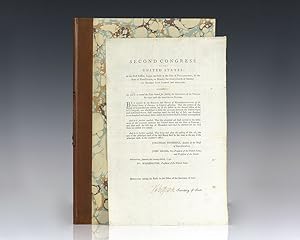
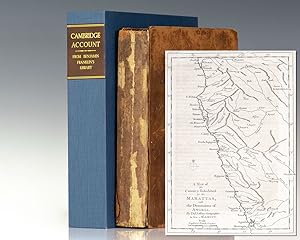
![Seller image for [Manuscript map of the "Waldo Patent" principally depicting the land between the Muscongus River and Penobscot Bay] for sale by Donald A. Heald Rare Books (ABAA)](https://pictures.abebooks.com/inventory/md/md11914361481.jpg)
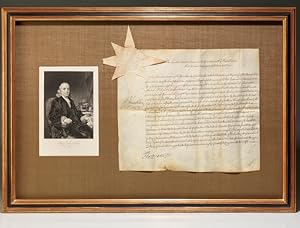
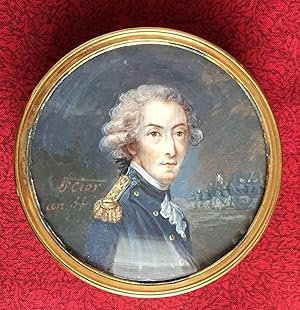

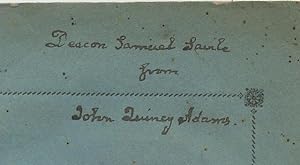


![Seller image for An Oration Addressed to the Citizens of the Town of Quincy on the Fourth of July, 1831; [together with:] An Oration Delivered Before the Inhabitants of the Town of Newburyport, at their request, on the Sixty-First Anniversary of the Declaration of Independence, July 4th, 1837. for sale by Peter Harrington. ABA/ ILAB.](https://pictures.abebooks.com/inventory/md/md30978817204.jpg)

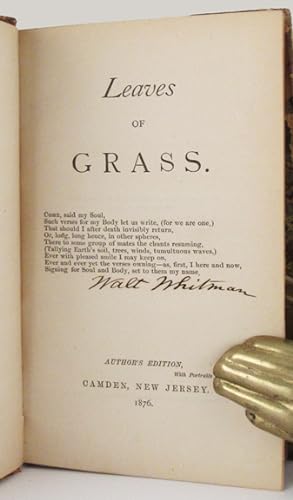
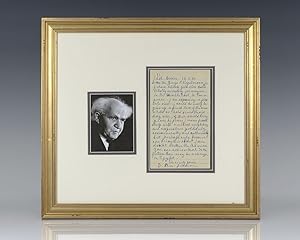
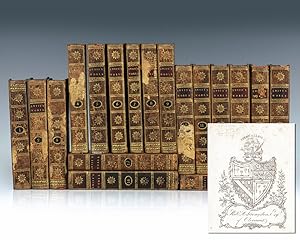
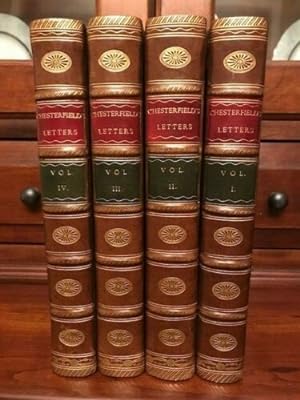
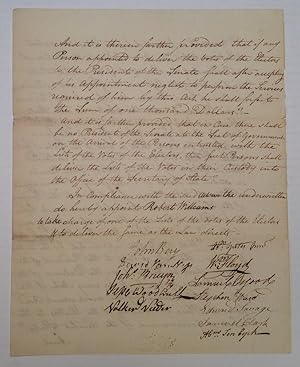
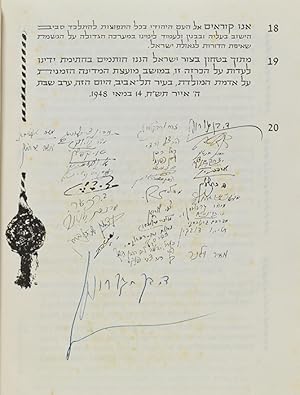
![Seller image for Declaration of the Establishment of the State of Israel [in Hebrew]. In: Iton Rishmi [in Hebrew],Official Gazette of Israel. - [THE BIRTH OF ISRAEL] for sale by Lynge & SÝn ILAB-ABF](https://pictures.abebooks.com/inventory/md/md31363371602.jpg)

